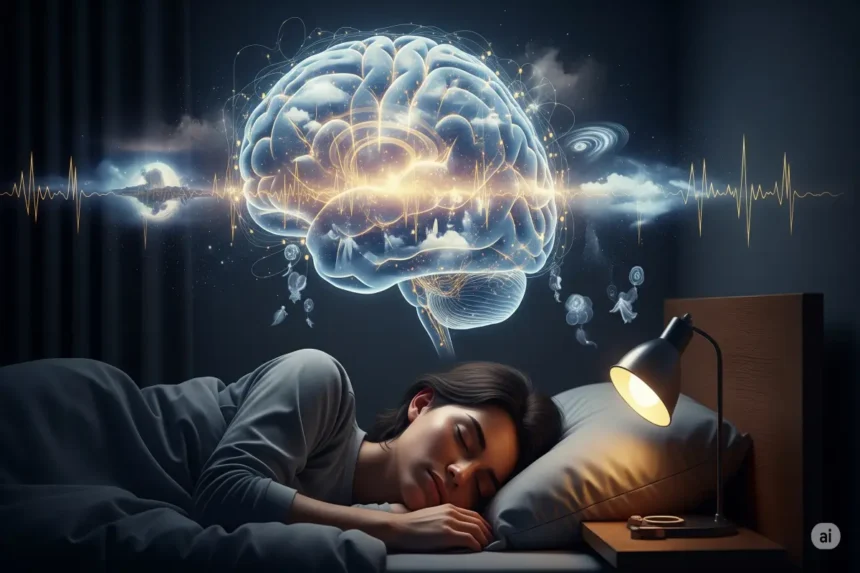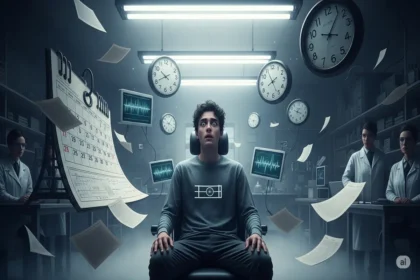The lights dim, the world outside fades, and we surrender to the nightly embrace of sleep. For hours, our bodies lie still, yet within the confines of our skulls, an extraordinary drama unfolds. We traverse landscapes that defy physics, engage in conversations with long-lost loved ones, or find ourselves navigating scenarios of bewildering absurdity. This nightly foray into our subconscious is what we call dreaming, a universal human experience that has captivated philosophers and scientists for millennia. But beyond the often-bizarre narratives, there lies a profound biological ballet, a complex interplay of neural activity that forms the very science of dreams. How does our brain, this intricate organ, work while we sleep to create these vivid, often perplexing, internal movies?
My own fascination with dreams began not with grand scientific inquiry, but with the quiet, unsettling experience of recurring nightmares as a child. A particular one, involving a dark, shapeless presence in my bedroom, would leave me breathless and terrified upon waking. Yet, there were also dreams of soaring over familiar landscapes, a feeling of boundless freedom that lingered into the morning. These powerful, visceral experiences weren’t just fleeting images; they felt deeply significant, almost like messages from an unseen part of myself. This personal intrigue ignited a lifelong quest to understand the “why” and “how” behind these nocturnal narratives, to peel back the layers of mystery surrounding the incredible cerebral symphony that orchestrates our dream lives.
The Brain’s Nocturnal Symphony: Navigating the Sleep Stages
To truly grasp the mechanics of dreaming, we must first appreciate the dynamic nature of sleep itself. Sleep isn’t a singular, static state; it’s a meticulously choreographed journey through distinct stages, each serving unique restorative and processing functions. We cycle through these stages multiple times a night, typically every 90 to 120 minutes.
The journey begins with Non-Rapid Eye Movement (NREM) sleep, which is further divided into three stages:
- NREM Stage 1 (N1): The Gentle Descent. This is the lightest stage, the drowsy transition from wakefulness to sleep. It’s that fleeting moment when you might experience a sudden muscle twitch (a hypnic jerk) or feel like you’re falling. Brain waves begin to slow, and if dreams occur, they are typically fragmented images or sensations, easily forgotten. Think of it as the brain gently easing off the gas pedal.
- NREM Stage 2 (N2): The Stable Slumber. We spend about half of our total sleep time in N2. During this stage, our body temperature drops, heart rate slows, and brain waves show characteristic “sleep spindles” and “K-complexes.” These unique brainwave patterns are believed to play a role in memory consolidation and protecting us from waking up in response to minor disturbances. Dreams here are more common than in N1 but tend to be less vivid, often described as thoughts or fragmented scenes rather than full narratives. It’s a deeper, more stable form of sleep, preparing us for the truly profound rest to come.
- NREM Stage 3 (N3): The Deepest Restoration. This is deep sleep, also known as slow-wave sleep, characterized by large, slow delta waves in brain activity. This is the most physically restorative stage, crucial for growth hormone release, cellular repair, and strengthening our immune system. Waking someone from N3 often leaves them disoriented and groggy, a state known as sleep inertia. Dreams in this stage are less common, often simple, and rarely remembered upon waking. It’s the body’s essential maintenance period, a time for profound physical rejuvenation.
Following these NREM stages, we transition into the most fascinating act of the nocturnal play: Rapid Eye Movement (REM) sleep. This is the star of the show when it comes to vivid, narrative dreams. Characterized by rapid eye movements (hence the name), increased brain activity (often mirroring wakefulness), temporary muscle paralysis (atonia) to prevent us from acting out our dreams, and fluctuating heart rate and breathing. Our first REM period is usually brief, lasting about 10 minutes, but subsequent cycles lengthen, with the longest REM period occurring just before we wake up, often explaining why we remember dreams more clearly upon awakening. It’s during this unique state that our brains truly come alive in a profoundly different way, orchestrating the elaborate productions we call dreams.
The Brain’s Dream Team: A Neurological Orchestra at Work
During REM sleep, specific brain regions become hyperactive, while others dial down, creating the peculiar and often illogical landscape of our dreams.
- The Limbic System: The Emotional Engine. Structures within the limbic system, such as the amygdala (responsible for processing emotions, especially fear) and the hippocampus (crucial for memory formation), are highly active during REM sleep. This explains why dreams are often imbued with intense emotions – joy, fear, anxiety, sadness, or exhilaration. Our emotional processing system seems to work overtime, perhaps integrating and regulating the emotional experiences of the day, allowing us to process feelings without the immediate consequences of waking life. It’s like an internal emotional detox.
- The Visual Cortex: The Inner Projector. Despite our eyes being closed, the visual cortex – the part of the brain that processes visual information – is highly engaged. This internal activity, without external sensory input, generates the vivid imagery and “seeing” we experience in dreams. It’s as if our brain is running its own private movie theater, complete with intricate sets, characters, and special effects, all conjured from within.
- The Prefrontal Cortex: The Logic Dimmer Switch. Here’s where things get interesting. The prefrontal cortex – the brain’s executive control center, responsible for logical reasoning, planning, decision-making, and self-awareness – is significantly less active during REM sleep. This reduced activity is believed to be why dreams often lack coherence, defy logic, and feature bizarre narratives. It’s why we rarely question flying cars or talking animals in a dream until we wake up. This temporary suspension of critical judgment allows for the free association and outlandish scenarios that make dreams so unique and often surreal.
- The Motor Cortex (and REM Atonia): The Body’s Safety Lock. While the motor cortex is active, sending signals for our bodies to move in the dream, a crucial protective mechanism called REM atonia kicks in. Neurotransmitters like glycine and GABA essentially “paralyze” our major muscle groups, preventing us from physically enacting our dream movements. This ensures we stay safely in bed, rather than punching walls or running through our house. Without this natural paralysis, our dream world could literally spill into our physical reality, leading to dangerous sleepwalking or acting out.
This unique combination of heightened emotional and visual activity coupled with dampened logical reasoning creates the rich, often bizarre, tapestry of our dreams. Dr. Robert Stickgold, a renowned sleep and dream researcher, describes it as the brain engaging in a kind of “offline processing,” consolidating memories, learning new skills, and even preparing for future events.
The Enduring Question: Why Do We Dream?
While the “how” of dreaming is becoming clearer, the “why” remains one of neuroscience’s most compelling mysteries. Numerous theories attempt to explain the purpose of this nightly mental spectacle, and it’s likely that dreams serve multiple, interconnected functions:
- Memory Consolidation and Learning: The Brain’s Nightly Rehearsal. One prominent theory suggests that dreams play a critical role in strengthening and integrating memories from the day. During REM sleep, the brain actively replays and reorganizes recent experiences, transferring information from short-term to long-term memory. Studies have shown that individuals who get adequate REM sleep perform better on memory tasks. For instance, a student might dream about a challenging concept they learned that day, and upon waking, find their understanding improved. It’s as if the brain is running a silent rehearsal, cementing new knowledge and skills.
- Emotional Regulation and Therapy: Processing the Day’s Feelings. Dreams, particularly those in REM sleep, are thought to be a kind of “night therapy.” The brain processes and defuses strong emotions experienced during the day in a safe, simulated environment. This allows us to integrate traumatic or stressful events, reducing their emotional impact. It’s like our brain’s internal therapist, helping us work through emotional kinks without the direct threat of real-world consequences. This could explain why we often dream about stressful situations, giving our minds a chance to cope and find resolution.
- Problem Solving and Creativity: The Muse of the Night. Many anecdotes highlight dreams as a source of inspiration and solutions. Famous examples include the discovery of the benzene ring by chemist August Kekulé, who dreamt of a snake eating its tail, or Paul McCartney’s melody for “Yesterday” appearing to him fully formed in a dream. The less inhibited nature of the dreaming brain, with its reduced logical constraints, may allow for novel connections and creative insights that are difficult to access in a conscious state. It’s a testament to the brain’s ability to innovate even when we’re not actively thinking.
- Threat Simulation Theory: Evolutionary Practice. Developed by Antti Revonsuo, this theory posits that dreams, especially nightmares, serve an evolutionary purpose: to simulate threatening situations, allowing us to practice fight-or-flight responses in a safe environment. This “practice” could enhance our ability to cope with real-life dangers. From an evolutionary perspective, it makes sense that our brains would use sleep as a training ground for survival.
- Activation-Synthesis Hypothesis: Making Sense of Chaos. Proposed by J. Allan Hobson and Robert McCarley, this theory suggests that dreams are essentially the brain’s attempt to make sense of random neural activity generated during REM sleep. The brain tries to weave a coherent story from these disparate signals, resulting in often illogical narratives. While initially focused on random activation, modern interpretations acknowledge the brain’s attempt to integrate this activity with memories and emotions, creating a narrative from the internal “noise.”
These theories are not mutually exclusive; it’s likely that dreams serve multiple functions, contributing to our cognitive, emotional, and physical well-being in complex ways.
Consider the experience of Leo, a young artist struggling with a creative block. He’d spent weeks trying to conceptualize a new sculpture, feeling utterly drained. One night, after a particularly vivid dream where he saw intricate, flowing forms emerge from a block of ice, he woke up with a clear vision. “It was like my brain had been working on it all night, unburdened by my conscious frustration,” he told me. “The dream wasn’t just random; it was a solution.” Leo’s story illustrates how the dreaming brain can tap into a wellspring of creativity, offering insights that elude our waking minds.
The Uncharted Depths: What Still Lies Beyond Our Grasp
Despite significant advancements in neuroscience, the science of dreams is still in its infancy. We don’t fully understand:
- The precise neural mechanisms: While we know which brain areas are active, the intricate neural circuitry that generates specific dream content and its unique subjective qualities remains elusive. How exactly do neurons fire to create the sensation of flying or the vivid taste of a dream meal?
- The subjective experience: Why do dreams feel so real, sometimes more vivid than waking life? How does the brain create such immersive, multisensory experiences from internal signals alone, without external input? The qualia of dreaming remains a profound philosophical and scientific puzzle.
- The universality vs. individuality of dreams: Are there universal dream symbols or archetypes that transcend cultures, or is every dream entirely unique to the individual’s experiences, memories, and subconscious? The debate between Jungian archetypes and purely personal symbolism continues.
- The role of consciousness: What is the exact nature of consciousness in the dream state, especially in phenomena like lucid dreaming, where self-awareness is heightened? How does the brain switch between unconscious narrative generation and conscious control within the same sleep stage?
These questions continue to drive dedicated researchers, pushing the boundaries of our understanding of the human mind. The dream state, far from being mere mental noise, is a crucible where memories are forged, emotions are processed, and creativity finds fertile ground. It’s a testament to the extraordinary complexity and adaptive power of the human brain.
As we surrender to sleep each night, we embark on an involuntary journey into our inner cosmos. Our brain, the tireless architect of our reality, continues its vital work, spinning tales that are sometimes bizarre, often profound, and always uniquely ours. To understand the science of dreams is to peel back a layer of this profound mystery, to appreciate the quiet genius at work within us as we rest. It reminds us that even in our deepest slumber, we are, in a very real sense, still profoundly alive and engaged in the fascinating process of being human, constantly processing, creating, and evolving.
Disclaimer: The information provided in this article is for general informational purposes only and does not constitute medical advice. It is not a substitute for professional medical advice, diagnosis, or treatment. Always seek the advice of your physician or other qualified health provider with any questions you may have regarding a medical condition. Never disregard professional medical advice or delay in seeking it because of something you have read on this website.












